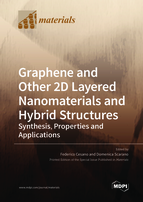Graphene and Other 2D Layered Nanomaterials and Hybrid Structures: Synthesis, Properties and Applications
A special issue of Materials (ISSN 1996-1944). This special issue belongs to the section "Materials Physics".
Deadline for manuscript submissions: closed (31 May 2021) | Viewed by 32871
Special Issue Editors
Interests: composite/hybrid materials and nanomaterials; surface Science; microscopies and spectroscopies; catalysis and photocatalysis
Special Issues, Collections and Topics in MDPI journals
Interests: 2D materials; carbons; oxides; polymers and their composite/hybrid materials and nanomaterials; piezoelectric and piezoresistive materials; functional materials; magnetic materials; interface and surface properties; microscopies and spectroscopies; electrical properties
Special Issues, Collections and Topics in MDPI journals
Special Issue Information
Dear Colleagues,
This Special Issue is dedicated to highlighting significant findings in the field of materials based on two-dimensional/layered systems, their hybrid structures, and composite materials. Graphene, together with a variety of newly developed 2D inorganic systems, have all attracted a remarkable amount of attention due to their unprecedented properties/superior performance encouraging their application in many fields. These two-dimensional systems are known for the fact that they are ultrathin, and hence tend to flexibility, also presenting nearly intrinsic and distinctive characteristics, including electronic, magnetic, optical, thermal conductivity, and superconducting properties. Furthermore, the combination of different structures and synergetic effects may open new and unprecedented perspectives, making these ideally assembled systems multifunctional and advanced materials. On this matter, significant examples come from the stacking together of 2D crystals, which can make materials perfectly tuned to the wavelengths of solar light. On the other hand, the ultralow sliding friction resulting from the contact between two crystalline materials or a crystalline material with a more disordered system makes superlubricity possible, which implies a reduction in friction of orders of magnitude compared to that measured for their 3D counterparts.
This Issue is primarily addressed to the two-dimensional (nano)structures and layered materials, from their syntheses/characterizations to their applications. Fundamental findings and theoretical studies contributing to the understanding of their basic principles are also welcomed.
The topics of interest include, but are not limited to, the preparation, properties, and applications of materials containing:
-Few-layered materials;
-Graphene and graphene-like systems (i.e., graphene oxide);
-Transition metal dichalcogenides, carbides, nitrides, carbonitrides;
-Silicene, germanene, stanene, and phosphorene;
-Van der Waals heterostructures, all-inorganic, and organic–inorganic hybrids;
-2D organic framework systems, 2D polymers.
Prof. Dr. Federico Cesano
Prof. Dr. Domenica Scarano
Guest Editors
Manuscript Submission Information
Manuscripts should be submitted online at www.mdpi.com by registering and logging in to this website. Once you are registered, click here to go to the submission form. Manuscripts can be submitted until the deadline. All submissions that pass pre-check are peer-reviewed. Accepted papers will be published continuously in the journal (as soon as accepted) and will be listed together on the special issue website. Research articles, review articles as well as short communications are invited. For planned papers, a title and short abstract (about 100 words) can be sent to the Editorial Office for announcement on this website.
Submitted manuscripts should not have been published previously, nor be under consideration for publication elsewhere (except conference proceedings papers). All manuscripts are thoroughly refereed through a single-blind peer-review process. A guide for authors and other relevant information for submission of manuscripts is available on the Instructions for Authors page. Materials is an international peer-reviewed open access semimonthly journal published by MDPI.
Please visit the Instructions for Authors page before submitting a manuscript. The Article Processing Charge (APC) for publication in this open access journal is 2600 CHF (Swiss Francs). Submitted papers should be well formatted and use good English. Authors may use MDPI's English editing service prior to publication or during author revisions.
Keywords
- 2D systems
- graphene
- graphene analogues
- layered materials
- hybrid structures
- van der Waals heterostructures
- synthesis
- properties
- characterization
- applications








